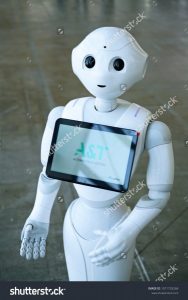-générique-
-intro cliché-
Presenter -Hello to the fans of robotic. Today, we welcome special guests who will tell us about robots in the army and in medicine
-virgule-
Presenter -Hello Thais Cagne you are an army engineer and ballistic in the french army
Thais -Yes indeed and i’m gonna present you the different robots that we can see in the army. Firstly the robots mine clearance experts which are used in the army because robots are more precise and limit the risk of explosion. Then, why should we risk the life of a human being robots can do the job very well.
Presenter -In daily life we talk a lot about drones and do you use them in the army ?
Thaïs -Yes drones are very important because they are used to spot enemies from a plane without pilots. we call these robots, “reconnaissance drones” but there are also “drones of fights” which are equiped with weapons.
Presenter -okay and I been told about a drone which is called SWORD I think, what is it?
Thaïs -Yes there was one report on that. So SWORD has been used by the American army since 2004. It is equiped with a machine gun, with one throw pomegranate of 6mm, with a camera. It can contain up to 300 chargers. But this machine of war can cost up to $250 000.
-virgule-
Presenter -Hello Doctor Servouze you are in the surgical part of the Saint-Michel Hospital in Issy Les Moulineaux , what do you think of robots in the medical field ?
Doctor -Hello, I am the doctor Servouze and I’m going to speak to you about a great innovation that are the robots in hospitals. For me, the robots represent the future because they allow very precise movements with the smallest instruments which will be extremely useful for the future.
Of course there will always be doctors. Robots are controled by the doctors so there will always be jobs in hospital.
Many robots were created for precise purpose and I’m going to present you three very completely different robots . At first I am going to present you the robot Nao that is the robot that gives information to visitors on the location of the room or on the service that was asked.
Secondly there is the Da Vinci robot which is a robot for the surgery. it was created in California and it allows to make more precise movements during an operation. robots do not replace the doctors, it helps the doctorwho controls the robots.
And finally I present you Pepper. the robot that accompanies patients and helps patients to recover. It is a help and not a handicap because it allows to helps us in everyday life. By asking the robot simple questions it can answer. This robot was already used with patients who were fully satisfied.
Presenter -And we have a patient who had the chance to test the robot named pepper, can you give us your opinion ?
Patient -Yes, pepper is a very sympathetic robot that helps you with a lot of things. for example when you forgot something or to plan some dates or appointments. The robot is only programmed to say and answer a dozen of phrases. You realise the robot is very limited in chatting but it is a good presence and companion. This robot really helped me with my medical treatment, during my stay in the Hospital. it remembered me a lot of things like “take your medicines” or “remember to wash you”, and it was very convenient.
Presenter – And have you got any experience with another robot?
Patient -Yes,of course. The welcoming robot “Nao” is a good boy *rire* it welcomes you in very good conditions, it says where is your room, what time it is, and it can call doctors when necessary. I have the same opinion as about Pepper. Nao is quite limited in the chitchat but very cute and sympathetic. it helps a lot and i think everyone agrees with me, we don’t really need robots in the hospitals, it is cool but a human can totally do this. And it’s more comfortable to be with a human, in short, i love these robots but they can easily be replaced.
Presenter – well this is the end of this program, thanks to everyone.
























